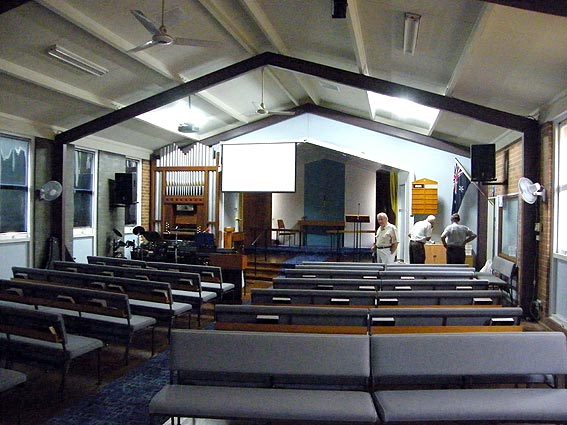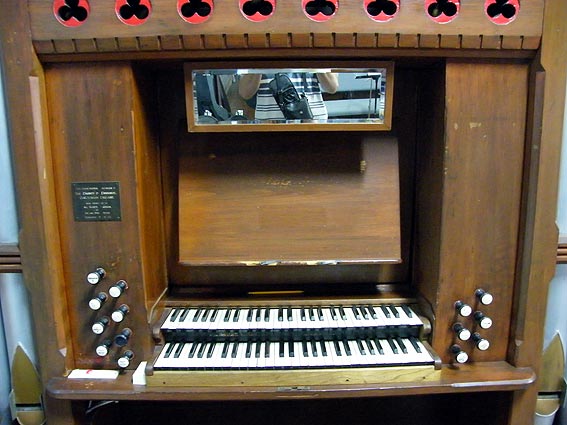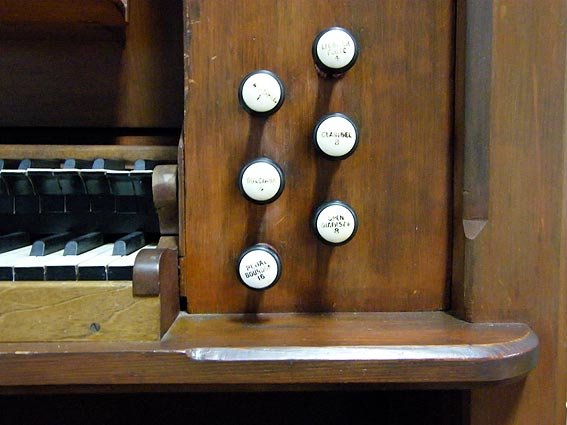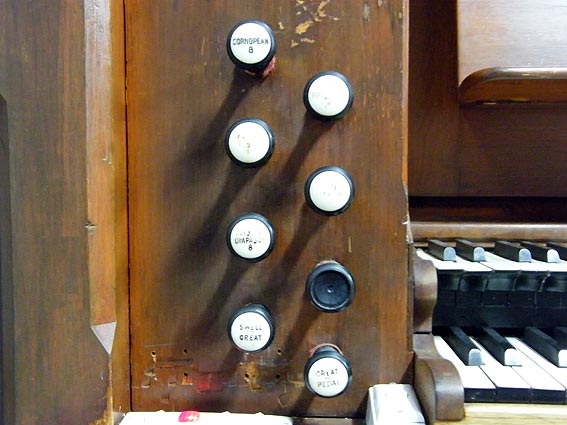All Saints' Anglican Church
cnr. Burdett St & Palmerston Road, Waitara
B. unknown (late 19th Century English)
Inst. from Emmanuel Church, Cheltenham, England 1965 A. Gee (church organist)
Some later tonal alterations 2 manuals, 11 speaking stops, 2 couplers, tracker action
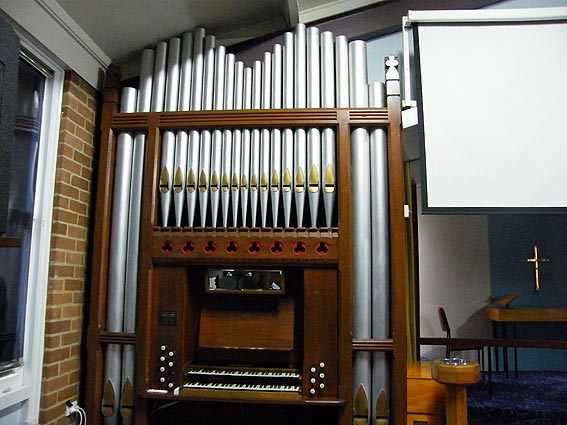
The organ came from the Church of Emmanuel, Cheltenham, UK and was dedicated on 26 September 1965. No builder’s plate. It probably dates from the 1870s or 80s.
Roy Williamson, researching the history of the church from where the organ came, writes (January 2008):
"The photo above clearly shows that the organ had to be shoe-horned into its chamber. Originally there were four Diapason basses each in the outer "towers".
The builder was almost certainly A J Price of Cheltenham who functioned with his sons succeeding him from 1878 to about 1950. His largest organ, 3 man GT 9, SW 12, CH 6, PD 5 but now 8, was built in 1896 for Trinity church, Cheltenham. It was electrified in 1954 by Nicholson - but it's still a nice instrument and highly significant to the town."
| GREAT Open Diapason Claribel Dulciana Principal Lieblich Flute Swell to Great SWELL Lieblich Bourdon Violin Diapason Lieblich Gedact Harmonic Flute Fifteenth Cornopean PEDAL Bourdon Great to Pedal |
8 8 8 4 4 16 8 8 4 2 8 16 |
[transposed to 4] # grooved bass [Swell Fifteenth in this slide] [not inserted] # grooved bass [Great Lieblich Flute at 2 in this slide] TC |
Compass: 56/30
Trigger swell lever
2 composition pedals to Great [removed]
Black metal pipework
Mechanical action to keys and stops
#possibly removed before the organ left the UK
Details noted by John Maidment August 1977
Details below noted by G Lloyd, 1st February 2008. Please note that further information is yet to be gathered.
Excerpts from “All Saints Anglican Church Waitara, Golden Jubilee History” November 2000.
A reed organ was used in the cottage church (first service 1950, dedicated 1951) until installed in the new church hall in 1959.
An electronic instrument was arranged in 1961. This became unreliable after some years of use.
A parishioner, Jack Reeks, born in Gloucestershire, England, returned there in 1964 to visit relatives. Whilst there, he purchased a “very fine pipe organ” from the Church of Emmanuel at Cheltenham, Gloucestershire and arranged packing and transportation to its new home at Waitara.
Arthur Gee, the then organist, installed it into an enclosure for which provision had been made.
There is a photograph on page 34 of the book, captioned “… Arthur Gee with Mr Jack Reeks at the dedication of the organ” on 26th September 1965.
Geoff Lloyd writes in the SOJ Autumn 2009:
According to All Saints Anglican Church Waitara – Golden Jubilee History (1950-2000), a retired Presbyterian minister, Richard Garner, bought the house The Laurels at 34 Palmerston Road in 1942. Following his death in 1948, and under the terms of his will, the property was able to be purchased in 1950 (then called Stenstone) and transferred to the then Church of England Property Trust. The short story is that All Saints’ (named as such a little later in the 1950s) was created as a subsidiary to St Andrew’s, Wahroonga. Thus the need for a Church of England house of worship, recognized by local residents since the end of the Second World War when the area had become populated, came to fruition with the “Waitara Cottage”.
A pipe organ for sale was found by a parishioner on a return visit to England in 1964. The organ from the Church of Emmanuel, Cheltenham, Gloucestershire, was duly purchased and shipped to Waitara, in the knowledge that space was available for its erection there. The organist of All Saints’, Arthur Gee, installed the organ (at the front of the “nave” adjacent to the chancel/sanctuary arch) and a dedication was held on Sunday, 26 September 1965.
A Sunday School had operated since 1946 in a local home and, from there also, a Ladies’ Guild, providing scripture lessons at Waitara school. The weatherboard “Waitara Cottage” was let out in 1950 with the proviso that the church be permitted to use the garage for Sunday School or church services when required. The Sunday School shortly transferred to the side verandah of the house. Classes were also held on the lawn in good weather and in the house in poor weather.
Evening Prayer was first held on Sunday, 17 December 1950 on the side verandah of the cottage. The Archbishop of Sydney dedicated the cottage on 8 September 1951 for the conduct of services. A gift of a reed organ was made during the same month. This instrument went into the new church hall in 1959.
All Saints’ became a Provisional District in 1971 and Provisional Parish in 1973. By 1958 matters had progressed to the stage where the cottage garage was lifted manually from Burdett Street to new footings on Palmerston Road. A church hall was erected, with the laying of the foundation stone on Sunday, 22 February 1959 and the opening festivities over the weekend of 20-21 June 1959.
The cottage was demolished and succeeded by a new rectory and hall in 1982. On All Saints’ Day 1984 the status of full Parish was attained.
Back in 1961, dissatisfaction with the reed organ resulted in its replacement by an electronic instrument, which became unreliable after some years of use.
Of two manuals (56 notes) and pedals (30 Notes) the specification is:
GREAT |
8 8 8 4 4 16 8 8 4 2 8 16 |
(iii) (bottom 6 grooved to Claribel) (ii) (wood – relatively new) (i) (vi) (bottom 12 grooved to Gedact) (wood) (v) (iv) |
NOTES:
- Actually Fifteenth 2
- Actually Stopped Diapason 8
- Bottom 11 out of service
- Bottom 12 out of service
- Actually Chimney Flute 2
- No pipes
Some tonal alterations have been carried out since the installation in the church.
Swell shutters are not installed (they are in storage, believed to be from the time of installation) although the original hitchdown pedal is in position. There is evidence that there were originally two combination (?) pedals. Some voluntary cleaning and restoration work has been effected in the past couple of years to maintain the organ in a playable condition.
It is understood that the late John Stiller documented the organ some years ago. That documentation has not been sighted at the time of writing this article.
The organ, of previously unknown builder but described as late 19th Century English, has served well the parishioners of All Saints’ and it remains a source of pride and pleasure to them.It was early 2008 that the Organ Music Society of Sydney dealt with an enquiry from a chap in the UK researching the history of his church and its organ, the organ which had been sent out to Waitara in the 1960s.
With the ensuing correspondence came the advice that the organ builder was almost certainly A J Price of Cheltenham who functioned with his sons succeeding him from 1878 to about 1950. The correspondent, referring to the photographs sent to him, saw that the organ had been “shoe-horned” into its chamber. He added that originally there had been four diapason basses each in the outer towers. The correspondent also advised that Price’s largest organ was about to be thrown out of Trinity Church, Cheltenham. Of three manuals and pedals (Gt 9, Sw 12, Ch 6, Ped 5 but now 8) dating from 1896 and “electrocuted by Nicholoshon” it was still a nice instrument, highly significant to the town but not used or appreciated by its … congregation.
The specification below is as found on the console.
